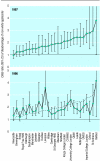Factors affecting likelihood of applicants being offered a place in medical schools in the United Kingdom in 1996 and 1997: retrospective study
- PMID: 9784446
- PMCID: PMC28692
- DOI: 10.1136/bmj.317.7166.1111
Factors affecting likelihood of applicants being offered a place in medical schools in the United Kingdom in 1996 and 1997: retrospective study
Erratum in
- BMJ 1999 Jan 9;318(7176):94
Abstract
Objective: To assess the relation between a range of measures and the likelihood of applicants to medical schools in the United Kingdom being offered a place overall and at each medical school, with particular emphasis on ethnic minority applicants.
Design: Data provided by the Universities and Colleges Admissions Service on 92 676 applications to medical schools from 18 943 candidates for admission in 1996 and 1997. Statistical analysis was by multiple logistic regression.
Main outcome measures: Receipt of a conditional or unconditional offer of a place at medical school.
Results: Eighteen separate measures were independently associated with the overall likelihood of receiving an offer. Applicants from ethnic minority groups were disadvantaged, as were male applicants, applicants applying late in the selection season, applicants making non-medical (so called insurance) choices, applicants requesting deferred entry (so called gap year), and applicants at further or higher education or sixth form colleges. Analysis at individual medical schools showed different patterns of measures that predicted offers. Not all schools disadvantaged applicants from ethnic minority groups and the effect was stable across the two years, suggesting structural differences in the process of selection. The degree of disadvantage did not relate to the proportion of applicants from ethnic minority groups.
Conclusions: The data released by the Council of Heads of Medical Schools allow a detailed analysis of the selection process at individual medical schools. The results suggest several areas in which some candidates are disadvantaged, in particular those from ethnic minority groups. Similar data in the future will allow monitoring of changes in selection processes.
Figures




Comment in
-
Is medical school selection discriminatory? New data should be used as a catalyst for change.BMJ. 1998 Oct 24;317(7166):1097-8. doi: 10.1136/bmj.317.7166.1097. BMJ. 1998. PMID: 9784441 Free PMC article. No abstract available.
-
Selection to medical school in Great Britain. Admissions procedure at St Andrews is driven by purely academic criteria.BMJ. 1999 Apr 3;318(7188):937-8; author reply 939. doi: 10.1136/bmj.318.7188.937a. BMJ. 1999. PMID: 10102869 Free PMC article. No abstract available.
-
Selection to medical school in Great Britian. Dundee university medical school has some questions.BMJ. 1999 Apr 3;318(7188):938; author reply 939. BMJ. 1999. PMID: 10232902 No abstract available.
-
Selection to medical school in Great Britian. Prejudice may not be responsible for difference in success rates.BMJ. 1999 Apr 3;318(7188):938; author reply 939. BMJ. 1999. PMID: 10232903 No abstract available.
-
Selection to medical school in Great Britian. League tables only help if uncertainty is properly looked at.BMJ. 1999 Apr 3;318(7188):938-9. BMJ. 1999. PMID: 10232904 No abstract available.
-
Ethnic and sex differences in selection for admission to medical school. Might selection criteria be surrogates for other determinants?BMJ. 1999 Dec 4;319(7223):1501; author reply 1501-2. BMJ. 1999. PMID: 10644153 No abstract available.
-
Ethnic and sex differences in selection for admission to medical school. Reanalysis using appropriate denominators shows that results and conclusions are flawed.BMJ. 1999 Dec 4;319(7223):1501-2. BMJ. 1999. PMID: 10644154 No abstract available.
References
-
- McManus IC, Richards P. Admission for medicine in the United Kingdom: a structural model. Med Educ. 1986;20:181–186. - PubMed
Publication types
MeSH terms
LinkOut - more resources
Full Text Sources
Miscellaneous
